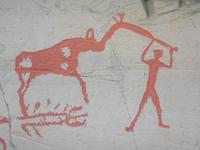
Photo. Rockcarvings in Alta, Norway. © Travel Explorations.
The rock art in Hjemmeluft, Kåfjord, Transfarelv, Storsteinen and Amtmannsnes are inscribed on the UNESCO's World Heritage List. The rock art in Isnestoften and Komsa are not part of the World Heritage. All the rock art sites in Alta are open-air sites.
Alta is located in the northern part of Norway. It`s the largest town in Finnmark county and offers northern lights, midnight sun, mountains, Sami culture, reindeer and UNESCO-protected rock carvings.
The first rock art in Alta was discovered 60 years ago. It was a small stone known as Pippisteinen ("The Pippi-stone"), which was found close to Isnestoften on the westside of the Altafjord.
You are welcome to watch more photos in the Alta Norway photo album on Travel Explorations on Facebook.
The rock art in Alta was inscribed on the World Heritage List on December 3rd 1985, as the only pre-historic cultural heritage monument in Norway. The world heritage in Alta consists of four areas of rock carvings (Hjemmeluft, Kåfjord, Amtmannsnes and Storsteinen), and one area of rock paintings (Transfarelvdalen).
Today there are more than 6000 registered carvings and paintings spread out over around a hundred panels. Out of this number the rock paintings constitute only six panels with about fifty paintings all together. The majority is carvings, and Hjemmeluft, where the World Heritage Rock Art Centre – Alta Museum is located, is the biggest area. This is also the only area that has been adapted for visitors.
I could easily understand that people who lived here in the past enjoyed themselves in the beautiful landscape, and that they wanted to express their feelings through illustrations.
Prehistoric rock art is a popular source of inspiration of modern art and crafts. If you are sports interested you might remember that the drawings from these carvings played a major role in the logo of the Winter Olympic Games in Lillehammer, 1994.
Among the many thousands of carvings is one depicting a skier in typical ski-skating posture. I overlooked this symbol on my walking tour through the rock carvings, but I could watch it in a book in the Alta Museum.
Norwegians claim to have invented the ski, but not only this. We have also invented modern technique in some of skiing disciplines: Is this the evidence for that we in Norway invented the Canadian Bill Koch cross country ski technique and the Swedish Jan Boklövs ski jumping V-style? I just wonder!
I would have stretched too far if I also claimed that the Norwegians have invented surfing, but one of the rock carvings looked like a person standing on a surfing board. It was more likely that this symbolized a person standing on skis.
There has also been discovered other rock carvings in Norway symbolising people on skis. The ‘Bøla Man’ was found in Steinkjer in the county of Nord-Trøndelag in 2001. The carving clearly shows a man on skis with a pole in his hand. This is the earliest evidence of skiing in Norway.
Before this, there had been the ‘Rødøy Man’ in Alstahaug municipality in the county of Nordland. The site in which this carving is located comprises a total of ten figures, although only the ‘Rødøy Man’, together with an imperfect carving, depict a man on skis. The site was discovered in 1933 by archaeologist Guttorm Gjessing. The ‘Rødøy Man’ was the inspiration behind the official pictograms of the XVII Olympic Winter Games that were held in Lillehammer in 1994.
Some of the rock carvings are very visible in the landscape in red colour. It`s amazing that they have lasted so long time. Many of the carvings are painted in order to show the figures more easily, and others will be kept as they are.
Stein Morten Lund, 3rd September 2012
Additional information
For more information about the rock carvings in Alta: Alta Museum.
The Ski Museum displays the Skier from Tro Island. The rock carving was used under the XVII Olympic Winter Games in 1994 at Lillehammer. The museum also tells the story of the recent developing in skiing and competitions.












